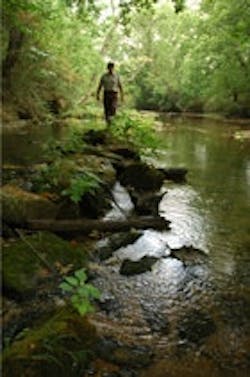U.S. Fish and Wildlife Service Announces 78 Projects in the Midwest
Throughout the eight-state Midwest Region, the U.S. Fish and Wildlife Service will undertake 78 construction, energy efficiency, habitat restoration and other improvement projects at national wildlife refuges, fish hatcheries and other public and private lands to create jobs and ensure our nation’s fish and wildlife resources, treasured landscapes, and rich heritage are conserved for future generations, Secretary of the Interior Ken Salazar announced.
These projects total approximately $28.9 million for improvements within the Midwest.
Funding for these projects and hundreds more across the nation comes from the American Recovery and Reinvestment Act of 2009. Of the $3 billion appropriated to the Department of the Interior, the Act provides $280 million for the U.S. Fish and Wildlife Service—including $115 million for construction, repair and energy efficiency retrofit projects at Service facilities, and $165 million for habitat restoration, deferred maintenance and capital improvement projects.
The Service will benefit from an additional $10 million, which is administered by the Department of Transportation and is not included in the Service’s $280 million appropriation that will be used to rebuild and improve roads on several national wildlife refuges. Projects will immediately create local jobs in the communities where they are located, while stimulating long-term employment and economic opportunities for the American public.
“These projects are an investment in America’s future that will help get our country moving again,” Salazar said. “They will enable us to preserve our rich history and natural heritage by conserving and restoring awe-inspiring landscapes, important historic sites and crucial wildlife habitat.”
The $28.5 million announced for the Midwest Region will go to U.S. Fish and Wildlife Service projects that include:
• Capital Improvements: $1.34 million;
• Deferred Maintenance of facilities and infrastructure: $15.3 million;
• Habitat Restoration: $3.16 million;
• Construction of new visitor centers and other facilities: $6.12 million;
• Reconstruction and Repair of Service buildings and other structures: $1.57 million; and
• Energy Efficiency Retrofits of Service facilities: $1.4 million.
The 78 projects are spread throughout all eight states, including: Illinois, Indiana, Iowa, Michigan, Minnesota, Missouri, Ohio and Wisconsin.
They will benefit both National Wildlife Refuges, such as the Upper Mississippi River National Wildlife and Fish Refuge – La Crosse District, Wisconsin, where more than $6 million will be spent to build an energy efficient office and maintenance facility; and National Fish Hatcheries such as Michigan’s Jordan River National Fish Hatchery, where $1.28 million will be spent to replace the hatchery’s effluent treatment facilities.
Some additional projects in the Region include $2.9 million for a water management ditch rehabilitation project at Agassiz NWR in Minnesota; $2.8 million for an accessible and energy efficient visitor center at Mingo NWR in Missouri; $1.2 million for energy efficiency improvements to the visitor center at Desoto NWR in Iowa; $700,000 for installation of a photo voltaic array for the visitor center at Ottawa NWR in Ohio; $640,000 for levee repairs at Chautauqua NWR in Illinois; and $70,000 for the Indiana Partners for Fish and Wildlife Program’s work to remove invasive species.
“The Midwest Region has a long tradition of enjoying the fish, wildlife, lakes, rivers and prairies we are so fortunate to have," said U.S. Fish and Wildlife Service Midwest Regional Director Tom Melius. “The projects we will undertake in the Midwest as part of ARRA will provide jobs, increase the energy efficiency of government buildings, protect and enhance our natural resources, provide greater opportunities for people to enjoy those natural resources, and perhaps most important, help current and future generations understand and share our passion for the natural world.”
All the projects announced represent long-standing priority needs identified by the U.S. Fish and Wildlife Service through its capital planning process. The Service worked through a rigorous merit-based process to identify and prioritize investments meeting the criteria put forth in the Recovery Act: namely, that a project addresses the Department’s highest priority mission needs; generates the largest number of jobs in the shortest period of time; and creates lasting value for the American public.
Source: U.S. Fish & Wildlife Service
